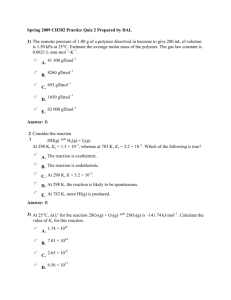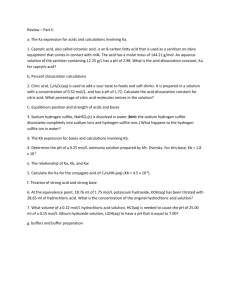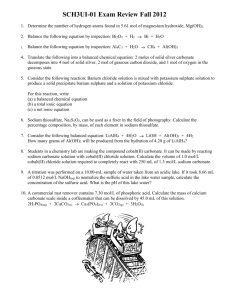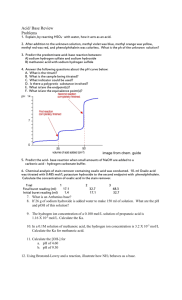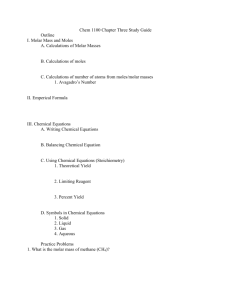Exam I review
advertisement
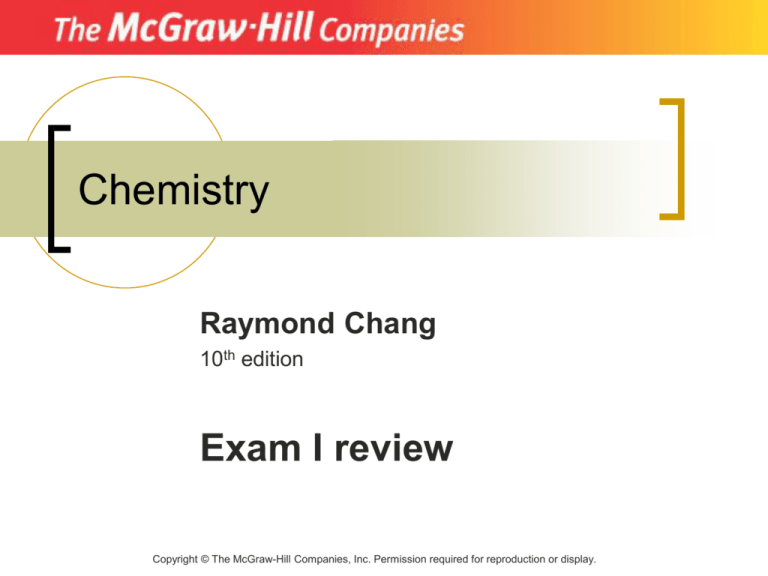
Chemistry Raymond Chang 10th edition Exam I review Copyright © The McGraw-Hill Companies, Inc. Permission required for reproduction or display. Question 2 Which of the following pairs of substances would be completely soluble in each other regardless of the 58% proportions combined? A) nitrogen gas and gaseous ammonia B) sodium chloride and water C) gasoline and water D) all of the above 26% 11% 5% 1 2 3 4 Question 3 Which of the following would produce a 25% by mass solution of sodium chloride in water? 58% A) 25 g of sodium chloride dissolved in 100 g of water. B) 50 g of sodium chloride dissolved in 200 g of water C) 25 g of sodium chloride dissolved in 75 g of water. D) both A and B. 32% 5% 1 5% 2 3 4 Question 4 The density of water is very close to 1.00 g/mL. If 3.00 moles of ethanol (molar mass 46 g/mol) is mixed with 1000. g of water, the solution will be 44% 44% A) 3.00 molar in ethanol. B) 3.00 molal in ethanol. C) 3.00% by mass ethanol. D) all of the above. 11% 0% 1 2 3 4 Question 5 Which of the following is true? A) The solubilities of solids in liquids always increase with temperature. B) The solubilities of gases in liquids always increase with temperature. C) The solubilities of solids in liquids rarely increase with temperature. D) None of the above. 50% 44% 6% 0% 1 2 3 4 Question 6 When a nonvolatile substance is dissolved in a liquid, the melting point of the solution will be lower than the melting point of the pure liquid. 26% A) True B) False 74% 1 2 Question 7 The freezing point depression constant is A) different for different solutes. B) different for different solvents. C) the same for all polar solvents. D) different for different temperatures. 47% 32% 16% 5% 1 2 3 4 Question 8 When solutions of different concentrations are separated by a semipermeable membrane that allows osmosis to occur, then A) there is a net flow of solvent to the side of the membrane with lower concentration. B) there is a net flow of solvent to the side of the membrane with higher concentration. C) there is a net flow of solute to the side of the membrane with lower concentration. D) there is a net flow of solute to the side of the membrane with higher concentration. 50% 39% 6% 1 6% 2 3 4 Question 10 A nonpolar liquid with a density of 0.870 g/mL is mixed in a beaker with water (density 1.00 g/mL). If the substances do not react chemically, then it is likely that A) two phases will form and the 95% water phase will be on top. B) two phases will form and the water phase will be on the bottom. C) most of the liquid will dissolve in the water, but some may remain undissolved. 5% 0% 0% D) the nonpolar liquid will be miscible in the water. 1 2 3 4 Question 12 Which compound will dissolve better in water? 33% 28% 28% A) CO2 B) CS2 C) Br2 D) SO2 11% 1 2 3 4 Question 16 Which NaOH solution is the most concentrated? (assume a density of 1.00 g/mL wherever necessary) 39% A) 10.0 % NaOH by mass B) 10.0 M NaOH C) 10.0 m NaOH D) They all have the same concentration 28% 17% 1 17% 2 3 4 Question 17 How would you achieve a high concentration of CO2 in a soda bottle? A) Keep the bottle capped B) Keep the bottle refrigerated C) Keep the bottle upside down D) B and C E) A and B 56% 39% 6% 1 0% 0% 2 3 4 5 Question 18 Seawater has an osmotic pressure of 33.0 atm at 25°C. Assuming seawater only contains disolved NaCl, what mass of NaCl is contained in 2.00 L of seawater? 56% A) 1.23 g B) 1.23 mol C) 144 g D) 72.0 g E) None of the above 22% 11% 6% 1 2 6% 3 4 5 Question 1 For the reaction 2A + B → C it is found that changing the concentration of A has no impact on the rate, but when B is doubled the rate doubles. The rate law is 50% 44% A) rate = k[A]2[B]. B) rate = k[A][B]2. C) rate = k[B]2. D) none of the above. 6% 0% 1 2 3 4 Question 3 Which of the following is true? A) A catalyst is not consumed in the reaction. B) A catalyst speeds up the forward reaction. C) A catalyst speeds up the reverse reaction. D) A catalyst 11% decreases the activation 5% energy. E) All of the above. 1 2 84% 0% 3 0% 4 5 Question 4 If a reaction is first order in one reactant and first order in the only other reactant, the units of the rate constant would be 65% A) Ms-1. B) M-1s. C) Ms. D) M-1s-1. E) none of the above 12% 12% 12% 0% 1 2 3 4 5 Question 6 Using the data below, determine the rate law for the reaction of A with B to produce C. Exp 1: 0.100 M A, 0.100 M B, rate 0.120 M/s Exp 2: 0.100 M A, 0.200 M B, rate 0.120 M/s Exp 3: 0.200 M A, 0.100 M B, rate 0.480 M/s 94% A) rate=k[A]2[B] B) rate=k[A]2 C) rate=k[B]2 D) rate=k[A][B] 6% 0% 1 2 3 0% 4 Question 11 Which of the following can be used to determine the rate of a chemical reaction? 78% A) Measuring a change in color B) Measuring a change in mass C) Measuring a change in concentration of a certain species D) All of the above E) None of the above 17% 6% 0% 1 0% 2 3 4 5 Question 15 In the reaction N2 + 3H2 → 2NH3, the rate of formation of ammonia at a given moment is 0.060 mol/s. What is the rate of reaction of hydrogen gas at the same 78% moment? A) -0.060 mol/s B) 0.090 mol/s C) -0.090 mol/s D) 0.040 mol/s E) -0.040 mol/s 6% 1 6% 2 3 6% 6% 4 5 Question 18 Which type of plot will be linear for a second order reaction? 83% A) [A] vs time B) ln[A] vs time C) 1/[A] vs time D) [A]2 vs time E) None is linear 11% 6% 1 2 3 0% 0% 4 5 Question 1 The reaction N2O4(g) ↔ 2NO2(g) is endothermic. Which of the following is true? A) Decreasing the pressure drives the reaction to the right. B) Increasing the temperature drives the reaction to the right. C) Decreasing the volume drives the reaction to the left. D) All of the above. 61% 28% 6% 1 6% 2 3 4 Question 2 If an equilibrium for a reaction is said to lie to the right then the equilibrium constant 78% A) is a negative value. B) is a positive value less than one. C) is a positive value greater than one. D) is equal to one. 17% 6% 1 0% 2 3 4 Question 13 Which of the following statements is true of a catalyst? A) Its concentration stays constant throughout the reaction B) it increases the rate of a reaction C) it provides a new pathway for the reaction D) all of the above E) none of the above 0% 1 0% 0% 2 3 0% 0% 4 5 Question 14 For reactions in gas phase, a relationship can be established between Kc and Kp. For which of the following processes will the two constants have the same numerical value? A) formation of water vapor from hydrogen and oxygen B) formation of carbon dioxide from carbon monoxide and oxygen C) synthesis of ammonia from hydrogen and nitrogen D) decomposition of hydrogen iodide into hydrogen and iodine gas 0% 0% 0% 0% E) conversion of nitrogen dioxide into dinitrogen tetroxide 1 2 3 4 0% 5 Question 15 Calculate the equilibrium constant for the process AB, given the following equilibrium concentrations: [N2O4] = 0.0427 M ; [NO2] = 0.0141 M A) 6.60x10-1 B) 215 C) 0.00466 D) 0.330 E) 3.03 0% 1 0% 0% 2 3 0% 0% 4 5 Question 16 Consider the following reaction: 4HCl(g) + O2(g) ↔ 2H2O(g) + 2Cl2(g) with DH = -114.4 kJ One way to decrease the amount of chlorine present at equilibrium is A) removing the water vapor while it is being formed. B) raising the temperature. C) adding more hydrogen chloride. D) decreasing the volume of the reaction vessel. E) none of the above. 0% 1 0% 0% 2 3 0% 0% 4 5 Question 19 Consider the following reaction: CaCO3(s) ↔ CO2(g) + CaO(s) . What will happen to the system if more CaCO3 is added? A) nothing B) the amount of CaCO3 will decrease C) less CaO will be produced D) the pressure will increase E) the concentration of CO2 will 0% 0% 0% 0% decrease 1 2 3 4 0% 5 Question 1 Which is true regarding the equilibrium below? HF(g) + H2O(l) ↔ F- + H3O+(aq) A) HF is acting as a Bronsted base. B) Water is acting as a Bronsted base. C) The reaction goes to completion leaving little HF. D) The Fluoride ion is acting as Bronsted acid. 0% 1 0% 2 0% 3 0% 4 Question 2 Which of the following is(are) true? A) pH can never be greater than 14. B) pH can never be less than 0. C) At room temperature, pH + pOH = 14. D) All of the above. 0% 1 0% 2 0% 3 0% 4 Question 3 Which of the following is a neutral salt (neither acidic nor basic)? A) KCl B) NaCN C) NH4NO3 D) NaF 0% 1 0% 2 0% 3 0% 4 Question 5 Which of the following has an impact on the percent ionization of a weak acid? A) The acid ionization constant. B) The concentration of the acid. C) Both A and B. D) None of the above. 0% 1 0% 2 0% 3 0% 4 Question 7 Which of the following will produce a basic solution when dissolved in water? A) Na2O B) NaOH C) Both A and B D) None of the above 0% 1 0% 2 0% 3 0% 4 Question 18 What will be the pH of a 1.0 × 10-8 M solution of HCl? A) 8.0 B) 6.0 C) cannot be calculated D) it will be slightly less than 7.0 E) it will be slightly more than 7.0 0% 1 0% 0% 2 3 0% 0% 4 5
